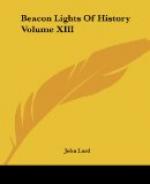The earlier works of Scott are drawn from memory and personal feeling, rather than from the knowledge he had gained by study. Of “Old Mortality” he writes to Lady Louisa Stuart: “I am complete master of the whole history of these strange times, both of persecutors and persecuted; so I trust I have come decently off.”
The divisional grouping of these earlier novels by Scott himself is interesting. In the “Advertisement” to “The Antiquary” he says: “The present work completes a series of fictitious narratives, intended to illustrate the manners of Scotland at three different periods. WAVERLEY embraced the age of our fathers [’’Tis Sixty Years Since’], GUY MANNERING that of our own youth, and THE ANTIQUARY refers to the last ten years of the eighteenth century.” The dedication of “Tales of My Landlord” describes them as “tales illustrative of ancient Scottish manners, and of the traditions of their [his countrymen’s] respective districts.” They were—First Series: “The Black Dwarf” and “Old Mortality;” Second Series: “The Heart of Mid-Lothian;” Third Series: “The Bride of Lammermoor” and “A Legend of Montrose;” Fourth Series: “Count Robert of Paris” and “Castle Dangerous.” These all (except the fourth series, in 1832) appeared in the six years from 1814 to 1820, and besides these, “Rob Roy,” “Ivanhoe,” and “The Monastery.”
With the publication of “Old Mortality” in 1816, then, Scott introduced the first of his historical novels, which had great fascination for students. Who ever painted the old Cameronian with more felicity? Who ever described the peculiarities of the Scottish Calvinists during the reign of the last of the Stuarts with more truthfulness,—their severity, their strict and Judaical observance of the Sabbath, their hostility to popular amusements, their rigid and legal morality, their love of theological dogmas, their inflexible prejudices, their lofty aspirations? Where shall we find in literature a sterner fanatical Puritan than John Balfour of Burley, or a fiercer royalist than Graham of Claverhouse? As a love-story this novel is not remarkable. It is not in the description of passionate love that Scott anywhere excels. His heroines, with two or three exceptions, would be called rather tame by the modern reader, although they win respect for their domestic virtues and sterling elements of character. His favorite heroes are either Englishmen of good family, or Scotchmen educated in England,—gallant, cultivated, and reproachless, but without any striking originality or intellectual force.
“Rob Roy” was published in the latter part of 1817, and was received by the public with the same unabated enthusiasm which marked the appearance of “Guy Mannering” and the other romances. An edition of ten thousand was disposed of in two weeks, and the subsequent sale amounted to forty thousand more. The scene of this story is laid in the Highlands of Scotland, with an English hero and a Scottish heroine;




